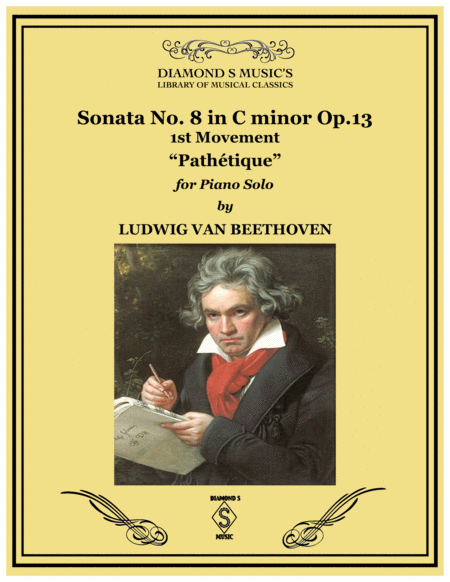Piano Solo - Level 5 - Digital Download SKU: A0.790152 Composed by Ludwig van Beethoven. Arranged by Diamond S Music. Classical,Concert. Score. 14 pages. Diamond S Music #4269079. Published by Diamond S Music (A0.790152). Piano Sonata No. 8 in C minor, Op. 13 - 1st Movement, commonly known as Sonata Pathétique, was written in 1798 when the composer was 27 years old, and was published in 1799. It has remained one of his most celebrated compositions. Although commonly thought to be one of the few works to be named by the composer himself, it was actually named Grande sonate pathétique (to Beethoven's liking) by the publisher, who was impressed by the sonata's tragic sonorities. Prominent musicologists debate whether or not the Pathétique may have been inspired by Mozart's piano sonata K. 457, since both compositions are in C minor and have three very similar movements. The second movement, Adagio cantabile, especially, makes use of a theme remarkably similar to that of the spacious second movement of Mozart's sonata. However, Beethoven's sonata uses a unique motif line throughout, a major difference from Haydn or Mozartâs creation. This is the original Beethoven arrangement of this sonata., commonly known as Sonata Pathétique, was written in 1798 when the composer was 27 years old, and was published in 1799. It has remained one of his most celebrated compositions. Although commonly thought to be one of the few works to be named by the composer himself, it was actually named Grande sonate pathétique (to Beethoven's liking) by the publisher, who was impressed by the sonata's tragic sonorities. Prominent musicologists debate whether or not the Pathétique may have been inspired by Mozart's piano sonata K. 457, since both compositions are in C minor and have three very similar movements. The second movement, Adagio cantabile, especially, makes use of a theme remarkably similar to that of the spacious second movement of Mozart's sonata. However, Beethoven's sonata uses a unique motif line throughout, a major difference from Haydn or Mozartâs creation. This is the original Beethoven arrangement of this sonata. The Full Sonata (all 3 movements) is avail at: S0.482163Other similar arrangements and selections from DIAMOND S MUSIC available at:https://www.sheetmusicplus.com/publishers/diamond-s-music/6940
